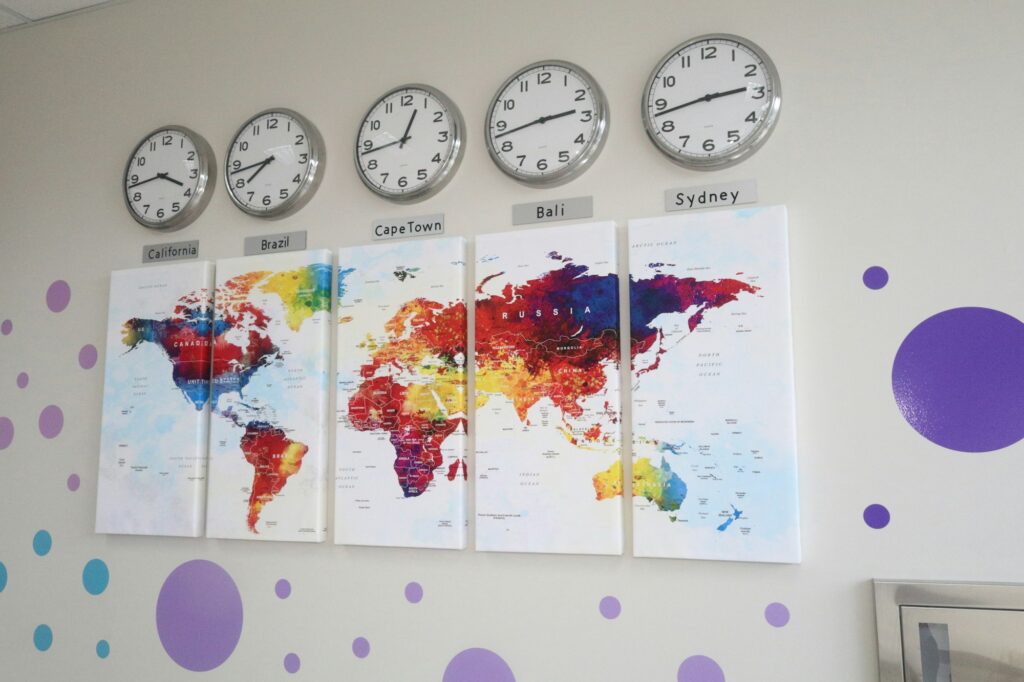
Managing remote teams has become the new norm. As companies continue to embrace remote work, they also face several distinct challenges that come with it.
If you’re leading a remote team, you’ve probably encountered issues like communication gaps, productivity concerns, and maintaining team morale.
Tackling these challenges can seem daunting, but with the right strategies, you can turn potential obstacles into opportunities for better collaboration and innovation.
“Remote work isn’t just a trend; it’s a fundamental shift in how we operate. Understanding the challenges is the first step towards mastering it.” – Jane Doe, Remote Work Expert
In this article, we will dive into the most pressing challenges of managing remote teams and provide practical solutions.
From improving communication to fostering a strong team culture, we’ll cover everything you need to know to lead your remote team to success.

Managing remote teams comes with a unique set of challenges, primarily revolving around communication, trust, and productivity. Let’s delve into these issues to understand their implications better and uncover potential solutions.
Communication barriers: Unlike traditional office settings, remote teams rely heavily on digital communication tools.
This dependence can lead to misunderstandings due to lack of non-verbal cues and delayed responses, often compounded by varying time zones.
It’s essential to ensure all team members are on the same page through clear and consistent communication.
Trust and accountability: Trust is harder to build in a virtual environment. Managers might struggle with the lack of visibility into daily activities, leading to excessive micromanagement or, conversely, a lack of oversight.
Establishing trust requires a delicate balance between independence and accountability, often reinforced through regular check-ins and transparent workflows.
Productivity concerns: Maintaining productivity across a distributed team is a significant challenge. Distractions at home, lack of a structured environment, and technology issues can all impact work output.
Encouraging a routine, providing the necessary tools, and fostering a results-oriented culture can help mitigate these productivity hurdles.
Each of these challenges requires a nuanced approach that addresses the individual needs of your team while also fostering a cohesive and collaborative remote working environment.
To effectively tackle the challenges of remote team management, it’s crucial to implement strategic solutions that cater to the unique needs of your distributed workforce.
Addressing communication hurdles, leveraging the right tools, and fostering a collaborative culture are key steps in this process.
Set clear communication guidelines to ensure everyone is on the same page. Regular video check-ins can help bridge the gap, making interactions more personal and reducing feelings of isolation.
Foster an environment where team members feel safe to voice their concerns and suggestions.
Select tools that enhance communication and productivity, such as Skype, Slack, and Trello. It’s essential to experiment with various platforms to determine the best fit for your team.
These tools can facilitate real-time conversations, project management, and file sharing, making remote collaboration seamless.
Time zone differences can pose significant challenges. Schedule meetings well in advance, considering all team members’ time zones to find the fairest times.
This consideration shows respect for everyone’s personal time and promotes a more inclusive team culture.
Remote teams often comprise members from diverse cultural backgrounds. Embrace and celebrate these differences to strengthen team cohesion.
Awareness of various cultural norms can also prevent misunderstandings and foster better communication.
Encourage team members to focus on one task at a time to improve productivity and reduce errors. Trust your team to perform their tasks without micromanagement.
Empowering them with responsibility can lead to higher job satisfaction and better performance.
Use tools that offer transparency on project progress and individual contributions. Clear and concise communication ensures that everyone understands the context and expectations.
This practice minimizes confusion and enhances team alignment.

Managing remote teams doesn’t have to be daunting if you follow some best practices designed to keep everyone on the same page and maintain productivity. Here’s how you can navigate the complex waters of remote team management:
Effective communication is the lifeblood of any remote team. Utilize tools like Slack, Microsoft Teams, or Zoom for daily stand-ups and regular check-ins.
But remember, communication isn’t just about frequency; clarity and context are equally essential. Encourage team members to be explicit in their messages to avoid misunderstandings.
ToolsThe right tools can make or break your remote team’s success. Platforms such as Trello for project management, Google Docs for real-time document collaboration, and tools like Skype or Zoom for video conferencing are invaluable.
Experiment with various platforms to find what works best for your team’s unique needs.
Set expectations about response times, meeting cadences, and preferred communication channels. This helps to avoid the message bombardment that can overwhelm team members and ensures everyone is on the same page.
Remote work can sometimes feel isolating. Regularly encourage collaboration through virtual brainstorming sessions, team-building activities, and peer reviews. This not only enhances teamwork but also helps in building a sense of community.
Multitasking can dilute focus and lead to mistakes. Encourage your team members to concentrate solely on the meeting at hand. This promotes more meaningful interactions and ensures that everyone is genuinely engaged.
Navigating time zones can be tricky but strive to find meeting times that are fair for all team members. Tools like World Time Buddy can help in identifying overlapping hours that are convenient for everyone.
Last but certainly not least, trust is a cornerstone of successful remote teams. Show your trust by allowing autonomy and avoiding micromanagement.
Trusting your team empowers them and boosts their confidence, leading to higher productivity.
By following these best practices, you’ll not only maintain productivity but also foster a positive and collaborative remote work environment.
Remote team dynamics are fundamentally different from those of co-located teams. Understanding these dynamics is crucial for successful management.
One of the most significant differences lies in communication. Unlike in traditional office settings where you can easily walk over to a colleague’s desk, remote teams rely heavily on digital communication tools.
To foster effective communication in this setup, it is imperative to establish a robust remote communication culture. This involves not just the tools you choose, but also the norms and practices your team adopts.
For example, clearly setting expectations around response times and preferred communication channels can mitigate misunderstandings and ensure that everyone is on the same page.
Moreover, remote team dynamics are shaped by the diversity and distribution of team members. This can be a double-edged sword.
On the one hand, a distributed team offers a rich tapestry of perspectives and ideas, which can fuel innovation and creative problem-solving.
On the other hand, this very diversity can lead to challenges, such as cultural misunderstandings and varying work habits.
It’s essential to leverage these strengths while also addressing the potential pitfalls. Facilitating regular virtual team-building activities and fostering an inclusive environment can help bridge gaps.
Encouraging team members to share their viewpoints openly and celebrating diverse contributions can further enhance team cohesion.
In summary, understanding and skillfully managing remote team dynamics involves a thoughtful approach to communication and a deep appreciation of the diverse backgrounds and locations that your team members bring to the table.
By doing so, you can transform potential obstacles into powerful advantages.

Building trust in a virtual environment is vital for any remote team to function effectively. Trust forms the backbone of any cohesive team, be it in-person or remote. However, with physical distance, fostering trust requires a strategic approach.
Clear and consistent communication: Communication is the bedrock of trust. Frequent and transparent communication helps in mitigating misunderstandings and builds a culture of openness and honesty.
Utilize tools like Zoom for regular video meetings or Slack for daily text-based updates to encourage connection.
Set personal etiquette and communication norms: Establish guidelines that promote respect and clarity in all interactions. This can include setting response time expectations or defining the levels of formality in communications. These norms prevent miscommunications and foster a respectful team environment.
Encourage team-building rituals: Designing virtual team-building activities can promote interaction and collaboration skills among team members.
Schedule regular non-work-related activities like virtual coffee breaks or team games to help your team build rapport and morale. Consider using platforms like Houseparty or Jackbox Games for fun, interactive sessions.
Leverage personal check-ins: Don’t focus solely on work discussions during team meetings. Take the time for one-on-one check-ins where you can discuss non-work topics too.
This approach humanizes interactions and shows genuine care for each team member’s well-being, thus building trust.
Implementing these strategies consistently will help create a work environment where trust flourishes even in the absence of physical presence.
Staying productive in a remote work environment often hinges on a combination of routine and flexibility. It’s crucial to establish a workspace that is conducive to focus and free from distractions.
Begin by designating a specific area of your home as your work zone. This creates a physical boundary between professional and personal activities, which can help you to mentally switch into “work mode.”
Stick to a Schedule: One effective strategy for maintaining productivity is sticking to a consistent schedule.
Start your day at the same time each morning, as this regularity can enhance your discipline and ensure you allocate sufficient time for your various tasks.
Prioritize Tasks: Utilize tools such as to-do lists or project management software to keep track of your tasks. Prioritizing your workload helps in tackling the most important tasks first and ensures that deadlines are met without last-minute rushes.
Take Breaks: Contrary to what some might think, breaks are essential for maintaining productivity. Short, regular breaks can help you recharge, reduce stress, and improve your focus.
Techniques like the Pomodoro Technique—which involves working for 25 minutes and then taking a 5-minute break—can be highly effective.
Leverage Technology: Utilize productivity apps and tools to streamline your workflow. Apps like Slack for communication, Trello for task management, and Zoom for meetings help in staying organized and connected with your team.
These tools can also provide a sense of community and mitigate the isolation that sometimes accompanies remote work.
Support Mental Health: Remember, productivity isn’t just about getting as much done as possible. It’s also about ensuring your well-being. Encourage open communication within your team about workload and mental health.
Support your team by being flexible with their needs and encouraging them to take time off when necessary.
By incorporating these strategies, you can create a balanced work routine that maintains productivity without sacrificing well-being.

Time zone differences are a common hurdle in remote team management, but they don’t have to be a roadblock. To tackle this challenge effectively, consider setting up overlap hours that work for most team members.
This approach ensures that everyone has a designated time window for real-time collaboration, making meetings and discussions more efficient.
One of the most effective ways to navigate time zone differences is through asynchronous communication. This method allows team members to respond to messages, emails, or tasks at their convenience.
Utilizing tools like project management software and shared documents can facilitate this process, ensuring that everyone stays aligned without the need for constant real-time interaction.
It’s vital to respect each team member’s working hours and personal time zones. When scheduling meetings, use tools that display multiple time zones, such as World Time Buddy or Google Calendar.
This makes it easier to find suitable times that don’t require anyone to sacrifice their personal time routinely.
Outline clear expectations regarding response times and availability. For instance, let your team know that while immediate responses aren’t necessary, acknowledging messages within 24 hours is crucial.
This balance helps manage expectations and reduces frustration caused by delayed communications.
By embracing these strategies, you can turn time zone differences from a challenging aspect of remote work into a manageable part of your team’s routine. Thoughtful planning and respect for everyone’s time make all the difference.
Establishing clear expectations and goals is crucial for the success of remote teams. It ensures everyone is on the same page and working towards common objectives.
When assigning tasks, be explicit about the expected outcomes and deadlines. This helps in preventing any ambiguity and maintaining productivity.
Prioritize Clarity: Always strive for clarity in your communications. Use simple and direct language to convey your message. Keep your instructions concise to avoid any miscommunication.
Decide On Agendas In Advance: Plan meetings with set agendas. This keeps discussions focused and ensures that all necessary points are covered. Sharing the agenda beforehand also allows team members to prepare adequately.
Set Clear KPIs: Establish Key Performance Indicators (KPIs) to measure the success of your communication strategies. This provides a tangible way to gauge whether your goals are being met.
Jason Akatiff, a noted expert, emphasizes the importance of providing the right context for trust in communication. To foster trust, make sure that your team has all the contextual information they need to perform their tasks effectively.
Effective communication processes help avoid misunderstandings. Set guidelines on the tone and channels to be used for different types of communication.
For example, use emails for detailed instructions and instant messaging for quick updates.
Consistently review and align goals by having regular check-ins. Each team should meet at least once a week to review their progress and ensure everyone remains aligned with the team’s objectives.
Overcoming communication barriers in remote teams requires a multi-faceted approach:
Effective management of remote teams relies on a suite of robust tools:
Building trust within a remote team involves deliberate actions and policies:
Maintaining work-life balance for remote team members is crucial for their well-being and productivity:
Managing conflicts in a remote team requires sensitivity and proactive measures:
Effective remote team management requires a blend of clear communication, trust, cultural understanding, and the right tools.
By addressing communication gaps, thoughtfully scheduling meetings, and celebrating the rich diversity within your team, you can create a harmonious and productive remote working environment.
Additionally, fostering collaboration skills and avoiding multitasking ensures that every team member remains focused and engaged during meetings.
Leverage asynchronous communication to navigate time zone differences, and set clear expectations to keep everyone on the same page.
Remember, the key to overcoming remote team management challenges lies in a proactive approach and continuous adaptation. Using these strategies, you can build a resilient and cohesive team that thrives in the virtual workspace.



